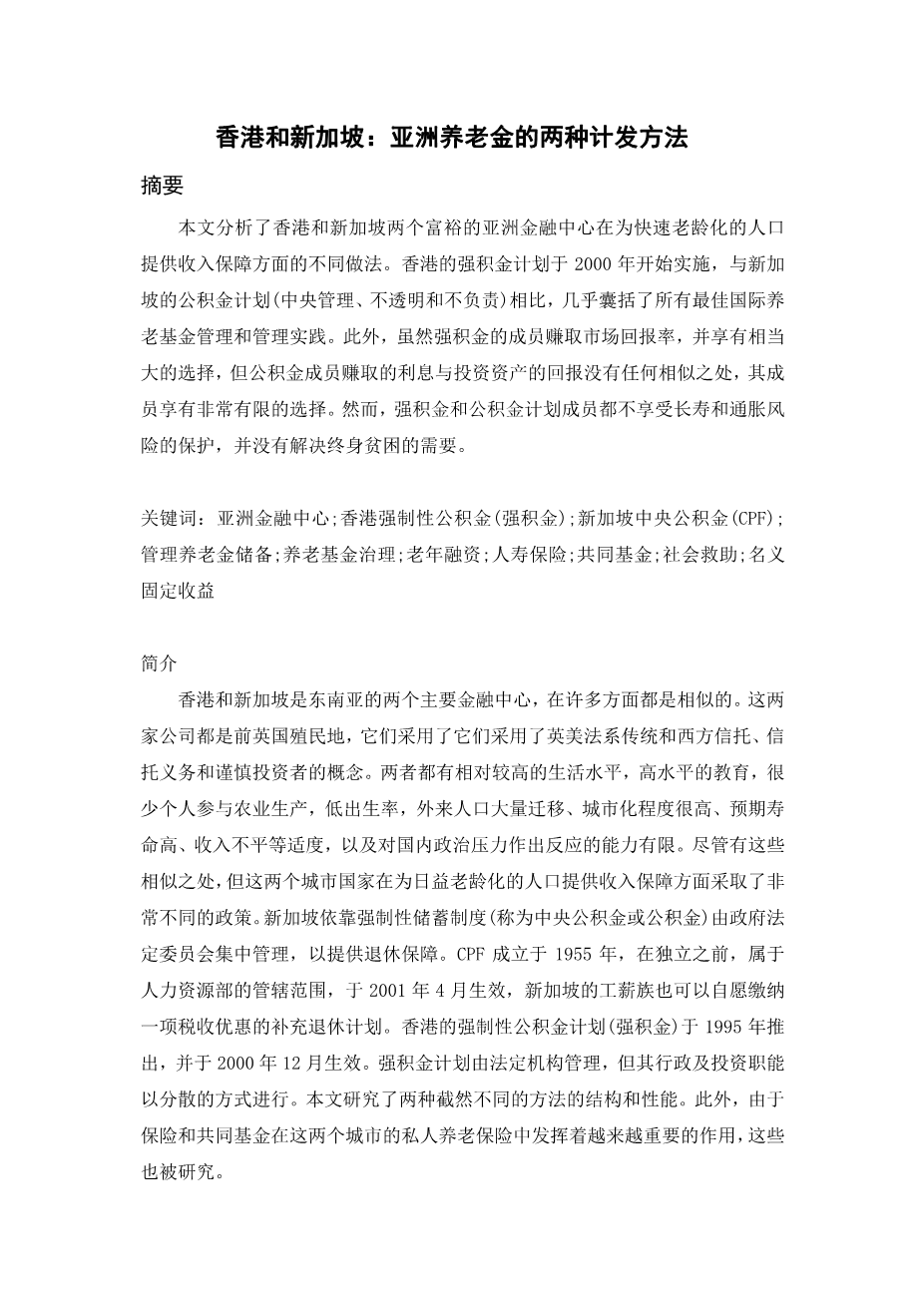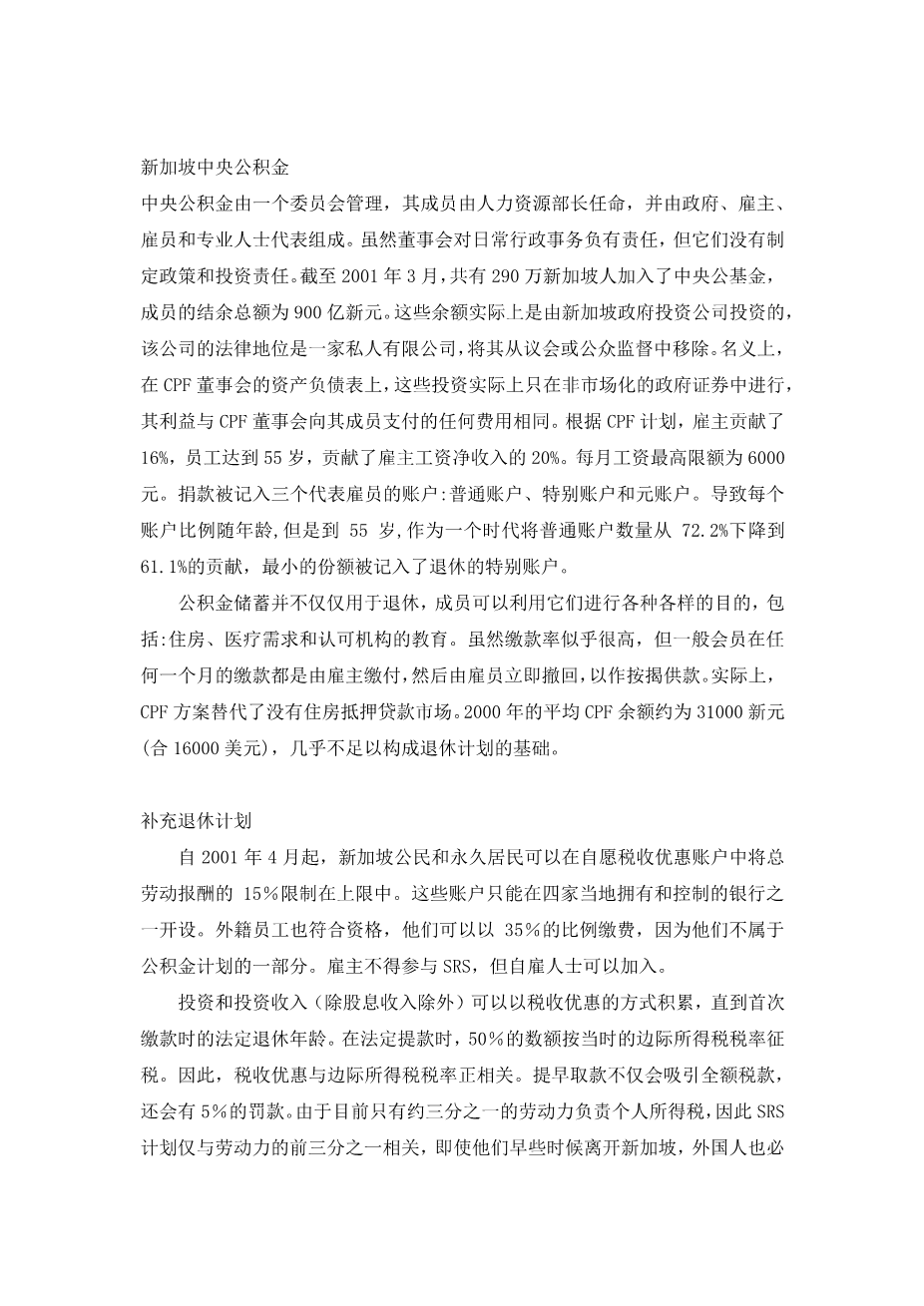Hong Kong and Singapore: Two approaches to the provision of pensions in Asia
Abstract
This paper analyses the differing practices of the two affluent Asian financial centres of Hong Kong and Singapore with respect to providing income security to their rapidly ageing populations. Compared to Singapore’s 50-year-old CPF, which is centrally managed, non-transparent and non-accountable, Hong Kong’s MPF scheme, begun in 2000, incorporates nearly all the best international pension fund management and governance practices. Moreover, while members of the MPF earn market rate of returns and enjoy considerable choice, CPF members earn interest that bears no resemblance to returns from investing their assets, and its members enjoy very limited choice. However, both the MPF and CPF members do not enjoy protection against longevity and inflation risks, and do not address the needs of the lifetime poor.
Keywords:Asian financial centers; Hong Kong’s Mandatory Provident Fund (MPF); Singapore’s Central Provident Fund (CPF); managing pension reserves; pension fund governance; financing old age; life insurance; mutual funds; social assistance; notional defined benefit
Introduction
Hong Kong and Singapore are the two major financialcentres in Southeast Asia are similar in many ways. Both are former British colonies that have adopted the common law tradition and Western notions of trusts, fiduciary duty and prudent investor. Both have relatively high standards of living, high levels of education, few, if any, individuals involved in agricultural production, low birth rates, considerable inward migrationfrom outside, very high levels of urbanisation, high life expectancy, moderate income inequality, and limited requirements to respond to domestic political pressures. Despite these similarities, the two city-states have adopted very different policies with respect to providing income security to an increasingly aged population.1 Singapore relies on a mandatory savings system (called the Central Provident Fund or CPF) managed centrally by a governmentstatutory board to provide retirement protection.2 The CPF was established in 1955, before independence, and falls under the purview of the Ministry of Manpower. Effective in April 2001, Singaporean wage earners can also voluntarily contribute to a tax advantaged supplementary retirement scheme. Hong Kong’s mandatory provident scheme (MPF) was introduced in 1995 and became operational in December 2000.3 The MPF is regulated by a statutory body, but its administrative and investment functions are undertaken in a decentralised manner. This paper examines the structure and performance of the two very different approaches. In addition, since insurance and mutual funds are playing an increasing role in the private provision of pensions in bothcities, these are also examined.
Singapore
Central Provident Fund
The CPF is governed by a board whose members are appointed by the Minister of Manpower, and comprisesrepresentatives of government, employer, employees, and professionals. While the CPF and its board have responsibility for routine administrative matters, they do not have policymaking and investment responsibilities. As of March 2001, 2.9m Singaporeans were members of the CPF and members’ balances totalled S$90bn. The balances are in effect invested primarily by the Government of Singapore Investment Corporation, whose legal status is that of a private limited company — removing it from parliamentary or public scrutiny. Nominally, on the CPF Board’s balance sheet, the investments is in effect only in non-marketable government securities, whose interest is the same as whatever the CPF Board pays its members. Under the CPF scheme, employers contribute 16 per cent and employees, up to the age of 55, contribute 20 per cent of wages net of employers’ share.4 There is a wage ceiling of S$6,000 per month. Contributions are credited into three accounts maintained on behalf of employees: ordinary account, special account and medisave account. The percentages contributed to each accountvary with age but up to age 55, as one ages the amount going to the ordinary account declines from 72.2 per cent to 61.1 per cent of contributions and the amount going to the medisave account increases from 16.67 per cent to 22.2 per cent of contributions. The smallest share is credited to the special account for retirement. Benefits vest immediately andare portable.
CPF savings are not just for retirement. Members are allowed to tap their balances for a variety of purposes including: housing, medical needs, and education in approved institutions. While contribution rates appear to be high, the typical member’s contributions in any given month are deposited by the employer and then immediately withdrawn by the employee to make a mortgage housing payment. In effect the CPF scheme substitutes for the absence of a housing mortgage market.5 Average CPF balances in 2000 are roughly S$31,000 (US$16,000) — hardly adequate to form the foundation of a retirement plan.
A member is permitted to invest his ordinary and special account balances in deposits, government bonds, statutory board bonds, government guaranteed bonds, deferred annuities, endowment insurance policies, and subject to further regulation, unit trusts, investment linked insurance products, shares, corporate bonds, and gold (see discussion of CPFIS below).
Supplementary Retirement Scheme
Effective from April 2001, Singapore citizens and permanent residents could save 15 per cent of their total labour compensation, subject to a ceiling, in a voluntary tax advantaged account. The accounts can only be opened at one of four locally owned and controlled banks. Expatriate employees are also eligible and they can contribute at a rate of 35 percent in recognition of the fact that they are not a part of the CPF scheme. Emplo
剩余内容已隐藏,支付完成后下载完整资料


英语译文共 9 页,剩余内容已隐藏,支付完成后下载完整资料
资料编号:[468924],资料为PDF文档或Word文档,PDF文档可免费转换为Word


